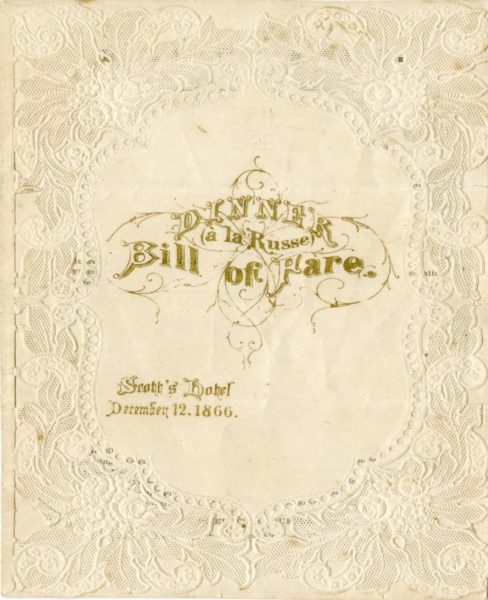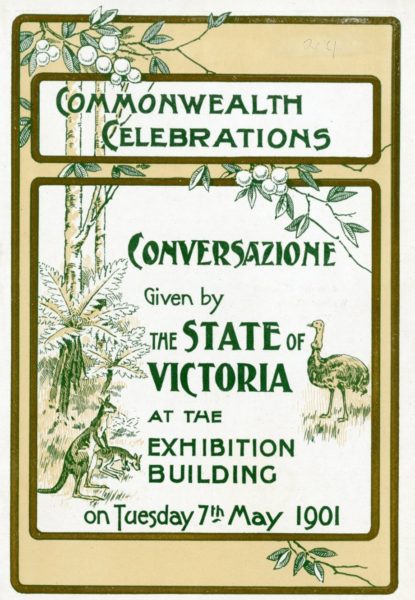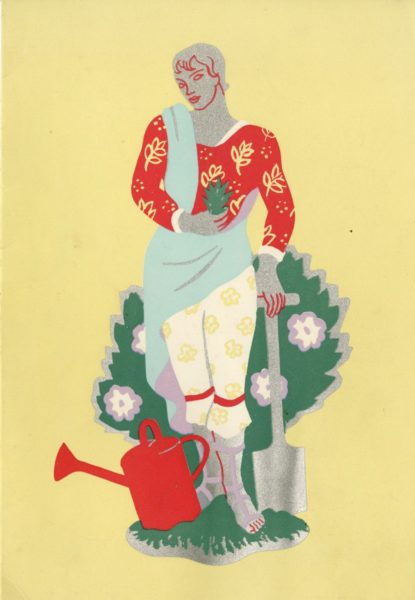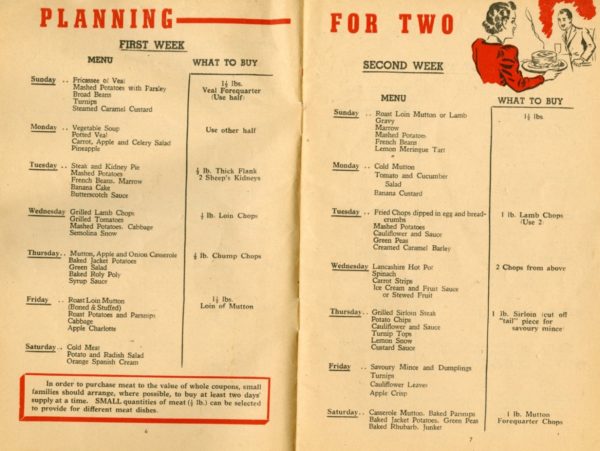Mandy Bede, volunteer at RHSV, President of the Ephemera Society of Australia
These menus have been extracted from the collection and are on display in the Cabinet of Wonders in the RHSV library until 6 April 2018
The earliest menus and bills of fare 1860s
According to Maurice Rickards ‘the social history of the table is little documented’ but where it is we can learn about: cuisine; price; design; and the rules of the table.
This selection of menus from the RHSV collection highlights some of the collection strengths: federation; Royal visits; travel (the ship menus); the American Fleet; and significant local venues.
The menus in the collection range from 1866 to date. The earliest are fine examples of the first guides to eating for diners which are believed to have come into use in Britain in the 1860s.
This menu for Scott’s Hotel offers ‘A la Russe’ dining which was a new style of service where diners had their own meals served on a plate and brought to them at the table. This menu has beautiful detailing: the cover has a perforated and die-cut border mimicking a lace tablecloth. As was the tradition until late into the 20th century in fine dining, the menu was written in French. Here the font is tiny gold print, almost too small to read.

In contrast the bill of fare was used when communal dishes were brought to the table and diners were served from the platters. This example is for a soldiers’ mess.

Commonwealth Celebrations 1901
An interesting group of menus is devoted to the Commonwealth Celebration and were designed with strong colours and sometimes featuring local flora and fauna. This is quite appropriate given nationhood and the first parliament were the subject of the celebrations be they an ‘At home’ or a ‘Conversazione’.

Note the waratah decoration for a Parliament of Victoria event, unlikely to be selected today as this is the floral emblem of New South Wales.

The celebratory meals drew on local vineyards while still providing imported champagne and whiskies. The menu description of food followed the tradition of the time using French rather than English. The caterer for all events was H. Skinner.
RHSV member Michael Magnusson advises:
H. Skinner was Henry Skinner, based at the Golden Gate Hotel, South Melbourne. As a caterer, he was noted for big civic events as well race meetings. Skinner won the tender for the Parliament opening (10s. 6d. per head) but demand exceeded supply along with other problems that caused many complaints about the catering during the occasion. Skinner still made a packet from it and continued in the business until a few years before his death in 1912, when he moved to enter local politics.

This cover is populated with an emu, wattle, ferns and kangaroos. Presumably a conversazione was a fashionable event in this era. According to the Merriam Webster dictionary website:
Writer Horace Walpole is credited with the first English use of conversazione in a 1739 letter in which he writes, “After the play we were introduced to the assembly, which they call the conversazione.” As this Italian borrowing was used through the years, it gained nuances of meaning. In Italy, it generally referred to a gathering for conversation, but in England it began to be used more for a private meeting. By the 19th century, conversazione also referred to assemblies and soirees of people connected with the arts or sciences. The word has two plural forms in English: conversaziones and conversazioni.
Ships’ menus
The ship menus, chiefly from the late 1930s, stand out with their beautiful illustrations. The Burns Philp menu from 1964 can be singled out for its design feature – the menu can become an illustrated souvenir to send to those onshore. The perforated edges where the coloured plate can be sealed can just be seen.

The following menus are from the Orient Line voyages taken in 1938. The designs range from woodcuts to beautiful full colour illustrations of the Earth and Air.


Rationing
Amongst all the glamour and ease of the menus, we have a reminder of eating post WW2 when rationing and so the challenge of making meals was present.




These menus are just a selection from the RHSV vertical file collection which houses material including ephemera. All catalogued menus can be located via eHive and by Trove.
The ephemera collection includes much more than menus. There are invitations, tickets, advertising, auction and exhibition catalogues, tourism and travel information all relating to Victoria and Victorians.
The RHSV welcomes donations and they can be made via the electronic form on the website.
As a volunteer at RHSV it has been an honour and a privilege to assist with the improved access to these wonderful records of Victorian social history.

 239 A'Beckett Street Melbourne, Victoria, 3000
239 A'Beckett Street Melbourne, Victoria, 3000  03 9326 9288
03 9326 9288  office@historyvictoria.org.au
office@historyvictoria.org.au  Office & Library: Weekdays 9am-5pm
Office & Library: Weekdays 9am-5pm

